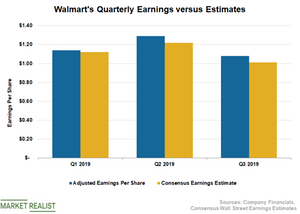What Could Hurt Walmart’s Profitability in 2019?
Walmart (WMT) had impressive earnings in the first three quarters of fiscal 2019. Walmart beat analysts’ expectations.
Jan. 4 2019, Updated 1:00 p.m. ET

Recent performance impresses
Walmart (WMT) had impressive earnings in the first three quarters of fiscal 2019. Walmart beat analysts’ expectations in the past three quarters. There was increased pressure on Walmart’s margins from its continued price invest to defend its market share, an unfavorable mix, and higher transportation costs.
Walmart’s bottom line benefited from the lower effective tax rate, the decline in the outstanding share count, and reduced interest costs. Target (TGT) and Costco (COST) had stellar bottom-line growth. However, the profit margins remained pressured due to value pricing and increased digital fulfillment costs.
Outlook
Buoyed by the better-than-expected performance in the first three quarters, Walmart increased its fiscal 2019 earnings outlook. Walmart’s bottom line is expected to be $4.75–$4.85 per share—up from its earlier guidance of $4.65–$4.80.
However, Walmart’s fiscal 2020 earnings are projected to decline by low-single-digits. Analysts expect Walmart’s EPS to decrease 2.6% in fiscal 2020, which reflects pressure on its margins. Excluding the Flipkart acquisition, Walmart expects its bottom line to increase by low to mid-single-digits. Walmart’s bottom line will likely benefit from improved sales and the lower outstanding share count. However, price investments in certain markets and an unfavorable mix, driven by increased e-commerce sales, are expected to remain a drag.
